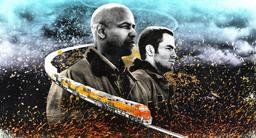There are many ways you can sell a film like F1 to audiences. It stars Brad Pitt, who, even at 61, remains one of the most magnetic heartthrobs in Hollywood. It’s the first movie to tackle modern-day Formula One, a sport that has skyrocketed in popularity, thanks in part to a companion Netflix docuseries. It’s the epitome of Dad Cinema. But what truly cements F1 as a can’t-miss theatrical experience is knowing it’s in very capable hands behind the camera:

Despite having just five previous movies under his belt, Joseph Kosinski has already established himself as a director with a serious blockbuster pedigree. An architect by training, Kosinski made his feature film debut with Tron: Legacy, which is essentially a $170 million Daft Punk music video (complimentary), and he’s stuck with big-budget projects ever since. Kosinski truly leveled up with Top Gun: Maverick, the highest-grossing movie of 2022 that no less an authority than Steven Spielberg believes saved theaters from a post-COVID death spiral. While Tron: Legacy dazzled with state-of-the-art CGI, Maverick’s selling point was its complex aerial sequences, in which Tom Cruise and the rest of the actors rode in the cockpits of fighter jets with actual Navy pilots. As Kosinski told The New York Times: “I think, as an audience member, something in your brain tells you it’s real, and there is a visceral response.” Can confirm, I was shitting myself when this happened.
Kosinski, then, is the perfect filmmaker for F1—going from warplanes to Formula One feels like a fairly seamless transition. But I reckon Kosinski isn’t just fascinated by aerodynamics: He’s following in the footsteps of another blockbuster auteur.
In making a Top Gun sequel, Kosinski was obviously deferential to the late Tony Scott, who directed the original film. A titan of the action genre, Scott was the Thinking Man’s Michael Bay, delivering maximalist entertainment with a keen eye for striking visuals. With Scott’s movies, style is substance, and while critics didn’t always favor his flicks, they were consistent box office draws. In other words, Scott built the kind of career worth emulating, and Kosinski appears to be mapping it onto his filmography. Top Gun notwithstanding, it’s easy to draw similarities between F1 and Days of Thunder, Scott’s underappreciated NASCAR drama. From F-14s to stock cars, Scott felt the need for speed.
If imitation is the sincerest form of flattery, then this is the case of one blockbuster filmmaker simply tipping his cap to another. Going forward, Kosinski isn’t done mining the past: He’s set to direct a movie remake of Miami Vice, which was already adapted into a feature film by Michael Mann, another big-budget auteur with a cult following. Respectfully, trying to out-Mann Mann is a losing battle—no matter how exquisite a new Miami Vice movie looks, it can never replicate what Colin Farrell and Gong Li were cooking up together. But when it comes to Scott’s filmography, Kosinski could be on to something: They could be fertile ground for spiritual successors rather than explicit remakes.
Below, I’ve compiled four Tony Scott movies that Kosinski could update for modern times. Some of these ideas might be as simple as incorporating the same mode of transportation; others would borrow the film’s premise more deliberately. Either way, if Kosinski ends up making any of these movies, I expect a consulting fee.
Crimson Tide
I had two major takeaways from Mission: Impossible—The Final Reckoning: One, Tom Cruise remains freakishly committed to putting his life in danger, and two, submarine-based action fucking rips. The Final Reckoning doesn’t really kick into gear until Ethan Hunt finds himself in the Bering Sea, hitching a ride on an American submarine before diving into the wreck of a Russian sub. Even among the franchise’s death-defying missions, a slab of metal being all that separates Hunt and his skintight boxer briefs from the icy depths of the ocean is the stuff of nightmares. It’s an all-time Mission: Impossible set piece, which raises the question: Where has all the submarine cinema gone?
In the 21st century, we’ve sorely lacked submarine-centric blockbusters; in fact, I’d argue the last great movie in this subgenre was Scott’s Crimson Tide, which follows the lead officers of an American nuclear sub (Gene Hackman and Denzel Washington) who are in conflict over whether to launch a strike against Russia. Given the present state of affairs with Russia, submarine cinema is ripe for a revival, and Kosinski could lead the charge. Maverick and F1 are defined by their practical action sequences, so why not do the same with a submarine? Imagine a teaser for a movie that opens with a “FROM THE DIRECTOR OF TOP GUN: MAVERICK” title card and closes with a shot of this thing moving through the ocean like an apex predator:

The plot? Give me a Russian nuclear submarine making its way through the Atlantic with a rogue artificial intelligence program that’s taken over the controls. (Just don’t call it the Entity.) Give me Liev Schreiber as the captain of an American submarine—he looks like a man who’d feel right at home at the bottom of the ocean—and the henchman with a heart of gold from Anora as the Russian commander trying to prevent World War III. Give me Hans Zimmer on the score, because it worked so well the first time on Crimson Tide. With someone of Kosinski’s talents, this is a billion-dollar idea in the making. Every dad in America would be at periscope depth for opening night.
Unstoppable
Scott described Unstoppable as “Speed on speed,” and it’s hard to disagree with that assessment. Based on the real-life incident involving a runaway train loaded with dangerous chemicals, Unstoppable is the American equivalent of a kaiju movie. Forget Godzilla; the scariest monster on the planet is an unmanned, 10,000-ton locomotive traveling over 70 miles per hour that doesn’t give a shit about your feelings—let alone horse trailers:

The problem is, Kosinski couldn’t direct something that copies Unstoppable beat for beat. There’s a reason Quentin Tarantino picked Unstoppable on The Rewatchables: It’s the greatest possible version of a film about a runaway train. But like Speed before it, all Kosinski has to do is borrow the outline of Scott’s movie and switch it to a different mode of transportation. So if trains and buses are a no-go, where does that leave us? Hear me out:
Yes, Speed 2: Cruise Control is one of the worst sequels ever made: It’s got a whopping 4 percent critics’ score on Rotten Tomatoes, it was nominated for eight Razzies, and it had the balls to replace Keanu Reeves from the first movie with Jason Patric. But my lizard brain also believes that it’s possible to make a crowd-pleasing blockbuster about an out-of-control cruise ship rigged to explode, and Kosinski could be the man to do it. Get a better script, get a better lead actor (hell, why not Keanu?), get Royal Caribbean to fork over one of the company’s kaiju-sized ocean liners, and we’re in business. (In the interest of keeping things topical, why not set the movie near the Suez Canal?) If Christopher Nolan can crash an actual 747 in Tenet, just imagine what Kosinski could do with a cruise ship. We, as a society, need Unstoppable on the high seas.
The Fan
It’s not unwatchable, but The Fan was a missed opportunity. A psychological thriller about a San Francisco Giants fan (Robert De Niro) obsessed with an MLB player (Wesley Snipes) newly signed by the team, Scott’s film sees De Niro chewing up scenery as much as he did in Cape Fear. One gripe, though: De Niro’s character has serious Boston sports fan energy. This man doesn’t belong at Oracle Park; he should be yelling from behind the Green Monster.
Alas, The Fan was a critical and commercial bomb, undermined by being a little too silly for its own good. (The reveal that De Niro is disguised as an umpire at the end of the film is hilarious for all the wrong reasons.) But there’s never been a better time for a reimagining. In the social media age, the relationship between fans and celebrities has only gotten thornier—Donald Glover’s Prime Video miniseries, Swarm, was a clever satire about obsessing over a Beyoncé-esque pop star. In the realm of sports, the dynamic is further complicated by the rise of legalized gambling—athletes are, sadly, increasingly subjected to online harassment and death threats. Seems like something Hollywood filmmakers would love to dramatize.
If Kosinski directed a modern remake of The Fan, the movie could tackle sports betting head-on, ideally striking a tone that both condemns this kind of behavior and underlines how absurd it all is. As for casting, between Everybody Wants Some!! and Chad Powers, there’s no movie star more suited to play a professional athlete than Glen Powell. Recasting the De Niro role is a bit trickier, but I have an idea that, if you’ll excuse the pun, is a little out of left field: Jason Mantzoukas. This dude’s default setting is chaotic as hell—playing an unhinged sports fan is absolutely in his wheelhouse.
Looks like a home run to me.
Man on Fire
Thanks to the success of the John Wick franchise, the past decade has given us an abundance of action movies about lonely instruments of death seeking vengeance. The Wickian knockoffs are defined by their balletic, gun fu fight sequences, but revenge thrillers have taken different forms in the 21st century; Taken, for instance, transformed Liam Neeson’s career into a nonstop barrage of dadsploitation cinema. In that vein, while it’s not regarded as one of Scott’s best movies, Man on Fire is much better than its reputation. The film stars Denzel Washington as a former CIA agent who goes to Mexico and becomes a bodyguard for the young daughter (Dakota Fanning) of a wealthy businessman before, you guessed it, she’s kidnapped and held for ransom. From there, Man on Fire goes hard. You haven’t lived until you’ve seen Denzel threaten a dude after implanting a bomb in his ass.
But if revenge flicks have become a dime a dozen, why would I want Kosinski to add to the pile? It’s simple: Every great blockbuster filmmaker should get the opportunity to cook and bring their own flavor to the subgenre. It’s also fun to see a new actor take on the loner out for revenge archetype, and for this particular remake, we needn’t look further than F1 to find someone. From his lead role on Snowfall, Damson Idris has been likened to Denzel—despite his idol not even knowing who he was a few years ago. And if Idris can do a mean Denzel impression, we might as well see what he can do in his own Man on Fire.
At this point, we know the ingredients for a proper revenge movie: Have a kid get kidnapped—is the teen from Adolescence available?—and we’re off to the races. The real question is what Kosinski would add as a director. Perhaps he can find a way to combine the CGI-heavy wizardry of his earlier films with the practical action anchoring Maverick and F1—imagine the Light Cycle sequences from Tron: Legacy but with actual motorbikes. (I’m already drooling at the prospect.) The biggest X factor, however, will be the setting. Mexico City was a character in its own right in Man on Fire; the John Wick movies have thrown their title character across the world. My suggestion, definitely influenced by inhaling the third season of The White Lotus: Let’s set this thing in Thailand.
Damson Idris chasing down kidnappers through Bangkok’s notoriously crowded Chatuchak Market? You couldn’t inject that into my veins quickly enough. If he managed to pull this off—along with these other Scott-esque executions—there’d be no two ways about it: Kosinski would be a Director on Fire. Until then, fellow Dad Cinema lovers, I’ll see you on the racetrack.




